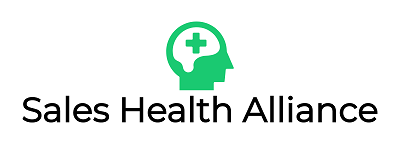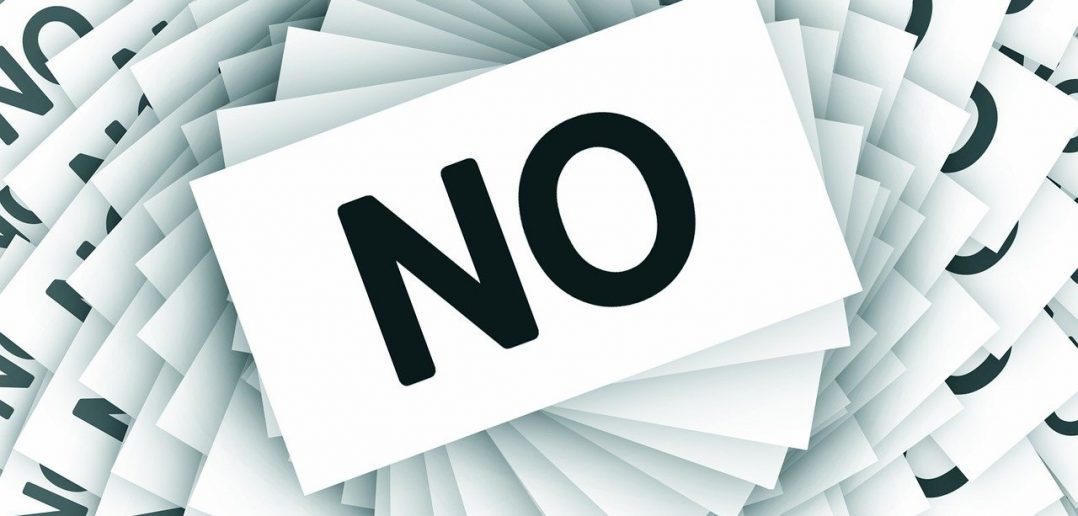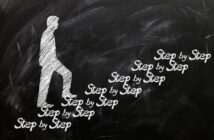Learning how to bounce back from rejection is a required skill if we wish to protect our Mental Health while working in sales. It is one of the most common questions I get asked during workshops and presentations because rejection really hurts.
It’s that simple.
Sometimes all it takes is hearing a single “No” on a deal you’ve invested months of effort into closing that can start a downward spiral. However more often in sales, it’s the smaller rejections that compound over time, which can impact us the most.
Without proper strategies to manage rejection in a mentally healthy way, each “No” will slowly erode our resilience. Rejection can start to snowball and push us further into emotional distress that will make us less effective at selling.
These smaller “No’s” create subtle changes in our mindset and belief system that are hard to notice. It’s not long before our confidence and optimistic mindset is replaced by self-doubt and intrusive negative thoughts. Without noticing, our internal talk track changes from something objective like:
“I HAVE failed to close that deal… I’ll do better next time.”
And switches to something more personal and hurtful as we adopt negative beliefs about ourselves like:
“I’M a failure… I’M not good enough…I AM not cut out for sales.”
So how do we bounce back from rejection in sales?
A quick Google search will provide us with several best practices for bouncing back from rejection. For example this article by Harvard Business Review provides some excellent suggestions:
- Understand the role of anticipation.
- Acknowledge pain without falling victim to it.
- Learn with humility.
- Find the courage to grow.
- Have the grace to let go of the rest.
These suggestions sound great on paper, but are extremely hard to implement when we have just been rejected for the 10th time in one day. What sales people actually need in order to bounce back from rejection is a Rejection Handle.
Project Mamba: Stop Letting Stress Impact Your Commission Check
Why You Need A Rejection Handle
When a sales call or meeting goes smoothly – we all have a plan for what to do next. We update our sales pipeline, take notes in our CRM and prep any documents our client needs to move forward. Having a plan gives us a process we can follow to ensure deals move closer to closing.
In a previous post I mentioned research completed by psychologist Robert Epstein. He surveyed over 30,000 people in 30 countries and found that the most effective method for reducing stress was having a plan. This is because creating a plan reduces uncertainty and makes us feel in control. It forces us to think about obstacles we may face and consider how to overcome them ahead of time.
When we feel in control, we’re motivated to act.
That’s why Objection Handles in sales are so effective. They are plans designed to overcome obstacles that may arise during a sales pitch. We may not know what a potential client is going to say, but we can feel confident because we have a plan to address any challenges that may arise.
Now think about when a sales call or meeting goes poorly. How many salespeople do you know, have a plan for what to do next? How many have plan to deal with difficult emotions like embarrassment, fear, hurt and self-doubt that may be felt following rejection?
Most salespeople do not have a plan. As a result they lose control and lose the motivation to act in a productive way. Without a plan, we lean on bad habits and behaviors to escape and avoid how we’re feeling. We do things like fake dial, avoid more challenging sales tasks or distract ourselves on social media. Worst case scenario we sit there paralyzed by our emotions.
This is why having a Rejection Handle is so important. It gives us a step-by-step plan that will help us navigate difficult emotions and bounce back from rejection in a mentally healthy way.
What Is a Rejection Handle
A Rejection Handle follows the same structure as your typical Objection Handle in sales:
If X happens, then I do Y.
Objection: If the buyer objects to the price, then – INSERT OBJECTION HANDLE.
Rejection: If I get rejected on this sales call, then – INSERT REJECTION HANDLE.
Y is your plan. Everyone’s plan may be a little different, but the most important thing is that you have one. It will ensure you feel in control and action good habits over bad habits when faced with vulnerable emotions.
Building a Rejection Handle will seem foreign to most salespeople, so I’ve outlined a 4-step process below that you can use as a foundation. It’s important to test various self-care and mindset strategies to find what works best for you.
Bounce Back From Rejection: “If I Get Rejected Then I…”
Step 1 – Assume Positive Intent
Assuming Positive Intent means no matter what happens – we assume the best in people. Adopting this mindset greatly improves our perspective and limits negative self-talk.
Facing rejection always creates some degree of uncertainty. Rarely will a buyer go into detail about why they’re rejecting our sales efforts and product. Usually it’s a simple “I’m not interested” email response or a click of the phone hanging up.
Anxiety feeds off situations like this. When we face uncertainty and ambiguity, our brain automatically starts to replace any missing data with an internal story it tells us. It tries to find a pattern using past experiences and assumptions to explain what happened.
When it successfully completes the pattern and creates a story that we believe, our brain rewards us with a hit of dopamine. We can feel in control again because ambiguity and uncertainty surrounding the situation has been removed.
Negativity Bias
On the surface this sounds amazing, but the problem is we’re all hardwired with a negativity bias. Even when two things – one positive and one negative – are of equal intensity, the more negative natured experience will be prioritized. What this means is we’re more likely to fill in the gaps in missing data and information with negative assumptions. This creates a perspective where we feel the need to blame and judge others. Even worse – we blame or judge ourselves.
We tell and believe untrue stories like:
“That buyer ghosted me because they’re just an a**hole.” (Blame/Judge the buyer)
“I missed target because I’m bad at sales.” (Blame ourselves)
“Cold calling doesn’t work because my product sucks.” (Blame the product)
Many of us drift through life being unaware of how our bias towards negative stories is leading us to tell the worst stories about ourselves and the people around us.
This is why Assuming Positive Intent should always be step number one in your Rejection Handle. When we assume positive intent in every experience we can override our tendency to blame and judge others.
Instead we tell stories like:
“Maybe my client is ghosting me because they’re feeling anxious and having trouble selling my product internally?”
“Maybe the rep on my team is unmotivated because they’re struggling with burnout?”
Assuming Positive Intent after every interaction allows us to create stories that are more compassionate and rooted in curiosity. This will help us form a more objective perspective and limit the difficult emotions often tied to rejection.
Project Mamba: Stop Letting Stress Impact Your Commission Check
Step 2 – “Best Thing That Could Have Happened…”
This phrase was something I learned from Kevin Bailey at Dreamfuel, who is doing some amazing work combining neuroscience with mindset in sales. According to Kevin, when we encounter rejection we need to build a habit of saying:
“Best thing that could have happened…”
Saying this out-loud and with conviction also engages an additional sense in our hearing. It makes this statement sound more real and more believable; something our brain can use to counter our immediate reaction to perceive the rejection negatively and go looking for something more positive to use in its story.
Then we finish our statement in the next step.
Step 3 – “… I just LEARNED X… I now KNOW Y…”
Now that we have shutdown the initial stress response, we need make sure our brain is absorbing the right information. Here are a few examples of how we can build off the statement in the previous step:
Example 1 – IF I get rejected on a cold call…THEN…
“Best thing that could have happened… I LEARNED my opening pitch needs more practice or tweaking”.
Example 2 – IF a buyer tells me they aren’t interested…THEN…
“Best thing that could have happened… I now KNOW I need to find a different point of contact.”
At any given moment we can only consciously process a limited amount of information, which means we need supercharge positive experiences. “I just learned” keeps our brain focused on perceiving the learning and growth we just experienced. “I now know” keeps our brain focused on perceiving the progress being made.
Keeping our attention focused on the learning and progress will help us override our negativity bias, making it easier to bounce back from rejection.
Step 4 – HALT
The last step of your Rejection Handle should always be to “HALT” before moving on to your next call or task. HALT is an acronym that stands for the following:
- Hungry?
- Angry?
- Lonely?
- Tired?
I personally HALT and ask myself these questions at least 10 times a day. I do this because I know if I’m answering Yes to any of these questions, I’ll be less effective during my next call or meeting. This means we increase the chances of being rejected due to poor performance and mental mistakes.
Sales is about controlling what you can control. Making sure we’re showing up Mentally and Physically healthy is the most important part of learning how to bounce back from rejection. Using HALT is a great way to ensure we have our basic needs covered.
Key Take-Aways: Learning How To Bounce Back From Rejection In Sales
We now have a plan and Rejection Handle to help us bounce back from rejection in sales. Using this plan after our next rejection will preserve our logical brain so we can respond with good habits, instead of reacting emotionally with bad habits.
Rejection Handle: IF I get rejected… THEN I…
- Assume Positive Intent
- Say “Best thing that could have happened…”
- Say “… I just LEARNED X… Or I now KNOW Y…”
- HALT before moving on.
Remember to experiment with your Rejection Handle and find a plan that works for you. Maybe you need to do something different after a cold call compared to a deal that falls through during the proposal stage. Maybe you need to meditate for 5 minutes, journal about what you’re feeling or take a walk.
Whatever you do – document it, write it down and keep your plan visible in your workspace.
For more best practices to improve sales performance, resilience and EQ through better Mental Health; subscribe to the newsletter or check out the services we offer.
Project Mamba: Stop Letting Stress Impact Your Commission Check
About The Author

Jeff Riseley is currently the Founder of the Sales Health Alliance and Mental Health Advocate. With over a decade of sales experience – Jeff understands the importance of Mental Health in achieving peak sales performance.
Jeff combines his sales (Sales Knowledge Institute) and Mental Health expertise to improve sales performance through a mix of sales mentorship and mental health best practices. His strategies have helped sales teams improve their sales process, while helping them become more motivated, resilient and better equipped to tackle stressful events within sales.
He is currently delivering these strategies through on-site workshops, coaching and speaking engagements. To explore working with Jeff contact him at [email protected]





2 Comments
Pingback: Podcast: Overcoming Stressful Situations in Sales - Sales Health Alliance
Pingback: How To Deliver Bad News In Sales - Sales Health Alliance